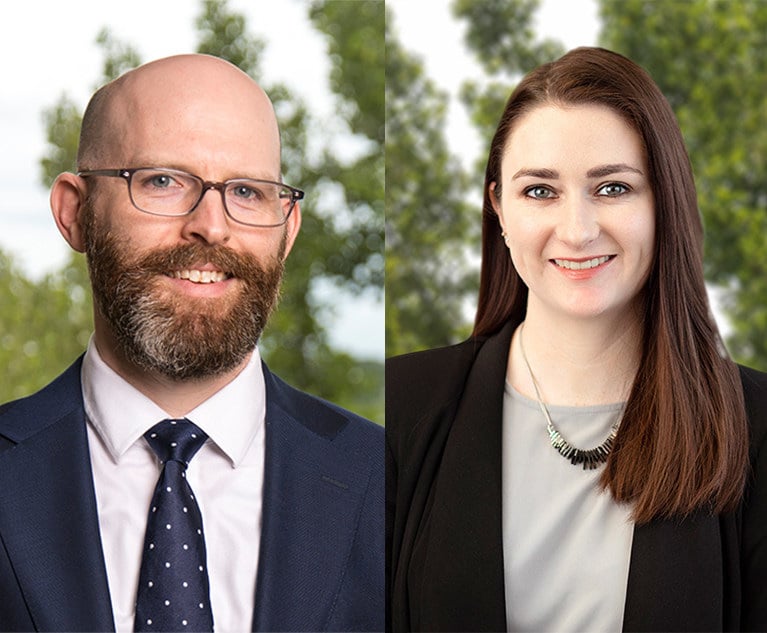COVID-19's Impact on Land Use and Development in New York
The pandemic continues to affect construction throughout the state, as well as everything from applications for building permits and land use approvals to public hearings and related litigation.
May 26, 2020 at 11:25 AM
10 minute read
By Anthony S. Guardino
 Anthony Guardino
Anthony Guardino
The novel coronavirus has had a crippling affect on virtually every aspect of our lives and livelihoods. We all are suffering the difficult circumstances, sicknesses, and deaths of family, friends, and colleagues.
This column focuses on a specific slice of the economy—land use planning and zoning—and how property owners, developers, and local officials in New York have dealt with, and how they continue to deal with, the ramifications of the coronavirus and COVID-19.
The Governor's Orders
On March 7, 2020, Governor Andrew M. Cuomo issued Executive Order Number 202, declaring a disaster emergency for the entire state given the existence of both travel-related cases and community contact transmission of COVID-19 in New York. As of this writing, the governor has followed that initial executive order with approximately three dozen related executive orders, available at https://www.governor.ny.gov/executiveorders.
Several days after the March 7 executive order, the governor issued Executive Order Number 202.1, which suspends Article 7 of the Public Officers Law, also known as the Open Meeting Law, to the extent necessary to permit any public body to meet and take such actions authorized by the law without allowing the public to be physically present at the meeting. The order authorizes meetings to be held remotely by conference call or a similar service, provided that the public has the ability to view or listen to the proceeding and that it is recorded and later transcribed.
Some local officials across the state, perhaps because they did not believe they had appropriate technology or because they were concerned about violating the law, simply shut down and decided not to conduct official business. Zoning and planning boards pondered how to proceed.
Many local governments, departments, and agencies began to hold "virtual" meetings by livestreaming them, while practicing social distancing, and have continued to operate. For example, the board of appeals of the Long Island town of Hempstead has begun holding public hearings by video conference with members of the board in attendance in the town hall auditorium. These meetings are livestreamed at https://hempsteadny.gov/meetings-and-hearings/live-streaming-video and are recorded for subsequent viewing. Interested members of the public can participate in the hearings and provide live comments by submitting their contact information to the board prior to the hearing date.
As another example: Meetings of the planning board and the zoning board of appeals (ZBA) of the town of Huntington, in Long Island's Suffolk County, have been broadcast live on government access TV as well as at HuntingtonNY.gov/meetings, where links to agendas for all meetings have been published ahead of time. There also are links where the public may view documents related to items on the agendas and meeting video feeds that have been made available for replay after the meetings take place.
In the town of Brookhaven, also in Suffolk County, the planning board and ZBA both are holding virtual public hearings that allow members of the public to participate in the hearings in real time. Interested persons may submit questions to the board about a particular application while it is being discussed using a "Q&A link" found on the Zoom meeting page.
Processing of Applications
With public buildings essentially closed, new procedures had to be created for parties to submit applications for variances, site plan review and other relief and for municipal boards to process and hear those applications.
Huntington's ZBA has developed extensive procedures to address this. These procedures, available at https://www.huntingtonny.gov/filestorage/13753/13761/ZBA_COVID_-19_PROCEDURES.pdf, require that residential and commercial applicants email their digital applications to the ZBA. Each application must contain a summary of the relief the applicant is seeking and an explanation of why it should be granted, including expert affidavits if deemed necessary or required as a matter of law. Cases already filed and online must be augmented with the additional submissions.
The ZBA uploads the packet for each application to the town's website 10 days before the hearing so that it is accessible to both board members and the general public. Applicants must notify by mail anyone within the notice radius; the public has 10 days from the date of that notice to email written comments to the ZBA. All public comments are put online and the matter is marked "fully submitted."
The "hearing" consists of a conference call or web conference with board members and the board's counsel on the line. The applicant and its representatives may listen to or view the proceeding, but may not participate live. The same is true for interested members of the public.
The proceeding is broadcast live on local public access channels and on the town website, and the ZBA's court reporter creates a transcript remotely from the broadcast. Decisions are filed with the clerk's office in the ordinary course of business.
Notwithstanding Huntington's procedures, and similar procedures adopted elsewhere, it is important to recognize that, as a practical matter, many local governments throughout the state have postponed public hearings, leaving applications in limbo, neither approved nor denied.
Statute of Limitations
Another complicating factor for applicants and boards is the suspension by the governor of the applicable statute of limitations, which exposes the board's decision to continuing litigation risk. Ordinarily, an action challenging the grant of a variance or approval of a site plan, special permit or subdivision application must be filed within 30 days after the decision is filed with the municipal clerk. That period has been suspended, which means that a challenge may be timely if filed well after 30 days and perhaps even after construction at a site has begun and expenses have been incurred. Successful applicants may refrain from commencing construction until they are confident that their litigation exposure has been diminished. As of this writing, it is not certain when that will occur.
Construction Restrictions
A local board's decision to approve an application for a building permit is typically good news for the applicant. Evaluating the benefits of an approval is much more complicated during the COVID-19 crisis. In essence, and depending on individual circumstances, it may be difficult for applicants to decide what they can—or should—do with a building permit issued now.
For one thing, construction has been limited, and in some instances completely barred, throughout the state pursuant to the governor's "NY on PAUSE" order. Originally, only "skilled trades, such as electricians and plumbers" and "other related construction firms and professionals for essential infrastructure or for emergency repair and safety purposes" were permitted to continue work.
Subsequent guidance from the state indicated that:
- All non-essential construction had to shut down except emergency construction, such as a project necessary to protect the health and safety of a site's occupants or to continue a project if it would be unsafe to shut it down until it became safe to do so;
- Essential construction such as roads, bridges, transit facilities, utilities, hospitals or health care facilities, affordable housing, and homeless shelters could continue; and
- A single worker who is the sole employee or worker on a job site could continue working.
The state made it clear that every essential or emergency non-essential construction site had to maintain social distancing, including for purposes of elevators, meals, entry, and exit. Sites that could not maintain distance and safety best practices had to close or face fines of up to $10,000 per violation.
The governor subsequently released interim guidance dated May 13, 2020 that applies to essential construction anywhere in the state and to non-essential construction in regions that have been permitted to reopen. The nine-page guidance, available at https://www.governor.ny.gov/sites/governor.ny.gov/files/atoms/files/ConstructionMasterGuidance.pdf, is organized around three distinct categories: people, places, and processes.
First, the guidance sets forth standards for physical distancing (for example, a distance of at least six feet must be maintained among workers at all times, unless safety of the core activity, such as dry walling, glazing, and lifting, requires a shorter distance); gatherings in enclosed spaces (for example, schedules should be staggered for employees to observe physical distancing for coffee breaks, meals, and shift starts and stops); and movement and commerce (for example, non-essential visitors on a worksite should be prohibited, and designated areas for pickups and deliveries must be established, limiting contact to the extent possible).
Next, the guidance requires that employees be provided with personal protective equipment (PPE); mandates compliance with hygiene and sanitation requirements as advised by the Centers for Disease Control and Prevention (CDC) and the New York State Department of Health (NYSDOH); and insists on the creation of a communication plan that includes applicable instructions, training, signage, and a consistent means to provide employees with information. The guidance states that development of webpages, text and email groups, and social media should be considered.
Finally, the guidance discusses the need for screening and testing (including mandatory daily health screening) as well as tracing and tracking (which requires, among other things, notification to the local health department and the NYSDOH when an employer is informed of any positive COVID-19 test result by a worker at a site).
Of course, developers that have obtained the required permits and authorizations to begin construction must carefully comply with all of these requirements if they decide to proceed.
Complicating the situation, however, is the fact that building permits typically expire within one year of being granted. Property owners may decide to delay accepting or even applying for building permits now, especially if the construction they seek to perform is "non-essential" and they are in a region that still does not permit non-essential construction. They also have to weigh the possibility that if they apply for and obtain a permit, they may not be able to complete construction within one year. (It should be noted that at least one jurisdiction—Long Island's Brookhaven—has extended the effective period of building permits issued during the COVID-19 crisis from one year to 18 months; other jurisdictions may follow suit.)
Conclusion
All businesses have been affected by COVID-19, including those associated with property development. As the state moves toward reopening, many of the issues that have limited local government and construction will be resolved, albeit under the framework and guidelines set forth in "New York Forward," available at https://www.governor.ny.gov/sites/governor.ny.gov/files/atoms/files/NYForwardReopeningGuide.pdf. Many questions remain to be answered, however, and local government officials and business people should consult with counsel and their other advisers to best ensure compliance with the new reality. Changes occur frequently, and everyone must fully appreciate what is required of us all.
Anthony S. Guardino is a partner with Farrell Fritz, P.C. in the firm's Hauppauge office. He can be reached at [email protected].
This content has been archived. It is available through our partners, LexisNexis® and Bloomberg Law.
To view this content, please continue to their sites.
Not a Lexis Subscriber?
Subscribe Now
Not a Bloomberg Law Subscriber?
Subscribe Now
NOT FOR REPRINT
© 2025 ALM Global, LLC, All Rights Reserved. Request academic re-use from www.copyright.com. All other uses, submit a request to [email protected]. For more information visit Asset & Logo Licensing.
You Might Like
View All
Don’t Blow It: 10 Lessons From 10 Years of Nonprofit Whistleblower Policies
9 minute read
Fusion Voting and Its Impact on the Upcoming Election
Law Firms Mentioned
Trending Stories
- 1Uber Files RICO Suit Against Plaintiff-Side Firms Alleging Fraudulent Injury Claims
- 2The Law Firm Disrupted: Scrutinizing the Elephant More Than the Mouse
- 3Inherent Diminished Value Damages Unavailable to 3rd-Party Claimants, Court Says
- 4Pa. Defense Firm Sued by Client Over Ex-Eagles Player's $43.5M Med Mal Win
- 5Losses Mount at Morris Manning, but Departing Ex-Chair Stays Bullish About His Old Firm's Future
Who Got The Work
J. Brugh Lower of Gibbons has entered an appearance for industrial equipment supplier Devco Corporation in a pending trademark infringement lawsuit. The suit, accusing the defendant of selling knock-off Graco products, was filed Dec. 18 in New Jersey District Court by Rivkin Radler on behalf of Graco Inc. and Graco Minnesota. The case, assigned to U.S. District Judge Zahid N. Quraishi, is 3:24-cv-11294, Graco Inc. et al v. Devco Corporation.
Who Got The Work
Rebecca Maller-Stein and Kent A. Yalowitz of Arnold & Porter Kaye Scholer have entered their appearances for Hanaco Venture Capital and its executives, Lior Prosor and David Frankel, in a pending securities lawsuit. The action, filed on Dec. 24 in New York Southern District Court by Zell, Aron & Co. on behalf of Goldeneye Advisors, accuses the defendants of negligently and fraudulently managing the plaintiff's $1 million investment. The case, assigned to U.S. District Judge Vernon S. Broderick, is 1:24-cv-09918, Goldeneye Advisors, LLC v. Hanaco Venture Capital, Ltd. et al.
Who Got The Work
Attorneys from A&O Shearman has stepped in as defense counsel for Toronto-Dominion Bank and other defendants in a pending securities class action. The suit, filed Dec. 11 in New York Southern District Court by Bleichmar Fonti & Auld, accuses the defendants of concealing the bank's 'pervasive' deficiencies in regards to its compliance with the Bank Secrecy Act and the quality of its anti-money laundering controls. The case, assigned to U.S. District Judge Arun Subramanian, is 1:24-cv-09445, Gonzalez v. The Toronto-Dominion Bank et al.
Who Got The Work
Crown Castle International, a Pennsylvania company providing shared communications infrastructure, has turned to Luke D. Wolf of Gordon Rees Scully Mansukhani to fend off a pending breach-of-contract lawsuit. The court action, filed Nov. 25 in Michigan Eastern District Court by Hooper Hathaway PC on behalf of The Town Residences LLC, accuses Crown Castle of failing to transfer approximately $30,000 in utility payments from T-Mobile in breach of a roof-top lease and assignment agreement. The case, assigned to U.S. District Judge Susan K. Declercq, is 2:24-cv-13131, The Town Residences LLC v. T-Mobile US, Inc. et al.
Who Got The Work
Wilfred P. Coronato and Daniel M. Schwartz of McCarter & English have stepped in as defense counsel to Electrolux Home Products Inc. in a pending product liability lawsuit. The court action, filed Nov. 26 in New York Eastern District Court by Poulos Lopiccolo PC and Nagel Rice LLP on behalf of David Stern, alleges that the defendant's refrigerators’ drawers and shelving repeatedly break and fall apart within months after purchase. The case, assigned to U.S. District Judge Joan M. Azrack, is 2:24-cv-08204, Stern v. Electrolux Home Products, Inc.
Featured Firms
Law Offices of Gary Martin Hays & Associates, P.C.
(470) 294-1674
Law Offices of Mark E. Salomone
(857) 444-6468
Smith & Hassler
(713) 739-1250








